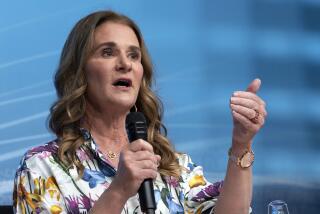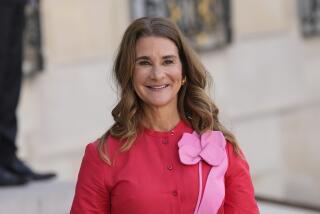Foundation Pools Women’s Donations
- Share via
SEATTLE — As a longtime volunteer for charities, Colleen Willoughby knew the satisfaction of trying to help others. Yet she sometimes worried that her $50 donation to a worthy cause was just a drop in the bucket. And where exactly did that money go?
These conflicting feelings led her in 1995 to found the Washington Women’s Foundation, to pool donations and encourage women in the fine art of generosity.
“We help women develop the confidence to make financial giving decisions by allowing them to be a part of a major donor group,” Willoughby said recently.
Willoughby’s foundation has gathered women of various economic means. Their joint contributions--a cool $1 million over three years--get noticed.
“I learned about the pleasure of giving away money for good causes,” said Dorothy Mann of Seattle, a member since 1996.
The foundation “allows women across socioeconomic lines to contribute to sizable grants that clearly make a difference.”
One example is Washington Works, a Seattle group that develops job training and placement contracts. It received $60,000 from the fund in 1997.
“It allowed us to have a full-time staff person,” said the group’s president, Jessie Walker. “I think the idea of pooling money by women is profound. . . . It made a huge impact on our organization.”
A 1996 donation of $100,000 went to the Seattle group Mothers Against Violence in America, for its Students Against Violence in America program.
President Pam Eakes said it helped ensure the group, then two years old, would continue its work. “We knew . . . what we were doing for the community was important,” she said.
Other grants helped finance a new arts-based curriculum for Seattle’s public schools, job training in food services for the homeless, and pediatric brain tumor research. A $50,000 grant helped environmental groups buy land in the upper Skagit River valley to protect it from development.
Willoughby, 64, noticed while volunteering with such organizations as United Way that women with money to contribute aren’t always sure where to send it. “The leadership role of women is evolving with more opportunities in the last decade or so,” Willoughby said. “We leave women feeling extremely empowered by making these independent and group financial decisions.”
New wealth in the Pacific Northwest, generated by Microsoft and other flourishing high-tech operations, is creating more potential philanthropists.
Arthur W. Schmidt Jr., head of Philanthropic Research, a nonprofit based in Williamsburg, Va., called the Washington Women’s Foundation “an excellent concept.”
“This is exciting because it’s an example of a proactive, creative response to philanthropy. These kinds of efforts will ultimately . . . ensure a more intelligent allocation of resources.”
Willoughby and four friends spent a year working out the concept before introducing it in 1995 to a gathering of about 100 friends, neighbors and co-workers.
Within three months, they had 100 members. Three years later, there are 235 members around the state who sign on for five-year periods. Members range in age from 20 to 80, with an average age of 50. By 2000, Willoughby predicts the foundation will have 500 members giving a total of $1 million annually.
Each member pledges $2,000 a year in cash or stock. The money is banked, and the interest is used to cover operating expenses. Willoughby is the foundation’s sole employee, working about 40 hours per week with no pay.
Half the money goes to up to three charities of the member’s choice. The other half goes into the pooled fund, which is used for $100,000 grants and occasional smaller awards.
There are two main rules:
* Coffers are emptied annually.
* The money goes to projects that will have local impact.
Willoughby found that most women’s charity groups target gender-related causes such as rape relief, child care and health issues. She doesn’t disagree with their goals; she just wanted to show other areas women can target.
Grant committees research community needs in five areas: cultural arts, social and health services, environment, education and health. Invitations to apply are extended to five groups in each area. After site visits, the committee winnows the list to five proposals. Final decisions are made by the membership.
“Grants are spread out over two to three years to show members that philanthropy is something you stay with,” Willoughby explained. “You don’t just write the check and walk away. We also do it for the accountability factor--to show members how they can influence the direction of a project by seeing the direct results of their money.”
More to Read
Sign up for Essential California
The most important California stories and recommendations in your inbox every morning.
You may occasionally receive promotional content from the Los Angeles Times.













